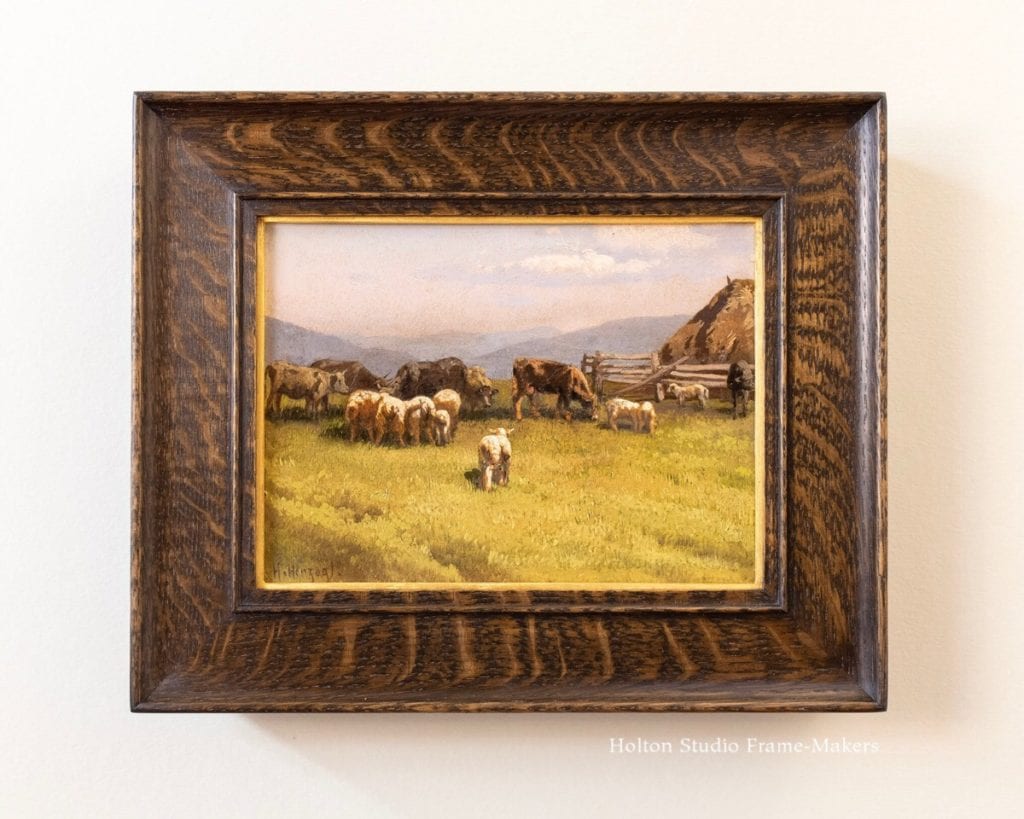We’ve decided to extend our show, Historical California Paintings. Originally scheduled to close tomorrow, August 31, we’ll keep it up for another week (through Saturday, September 7). If you haven’t seen the show yet, it’s a great opportunity to bask in the glow of some the work of notable painters like Thomas Hill, William Keith, Percy Gray, and Raymond Yelland. If you have stopped by, come have a second look while you can. In fact we’ve added a couple of paintings since the opening, including this small (just under 6″ x 8″) but charming and beautifully executed farm scene by German-American painter Herman Herzog, who came to California in the 1870’s. (We actually haven’t been able to verify whether the piece here was painted in California, but it certainly could’ve been, and in any case the influence California had on Herzog and the influence he had on the state’s painting legacy earns him a place in the show.)
The frame is our No. 308.0, a simple, refined cove with a bead near the sight edge, to which we added a 23 kt gold slip. The profile is 1-7/8″ wide. Eric Johnson made it. It’s in beautiful quarter sawn white oak with Medieval Oak stain.
About Herman Herzog
Hermann Ottomar Herzog (15 November 1832 – 6 February 1932) was a prominent nineteenth- and early twentieth-century European and American artist, primarily known for his landscapes. He is associated with the Düsseldorf school of painting.
He was born in Bremen, Germany and entered the Düsseldorf Academy at age seventeen. Herzog achieved early commercial success, allowing him to travel widely and continue his training. His patrons included royalty and nobility throughout Europe.
In the late 1860s, after an extensive trip to Norway, Herzog settled permanently near Philadelphia in the United States. Thereafter, he traveled throughout the U.S. and Mexico. He painted his way across the western states, arriving in California in 1873. His works from this trip included a series of Yosemite Valley paintings. In 1876, he received an award at the Philadelphia Centennial Exhibition for his painting of Sentinel Rock in Yosemite. Herzog also made extensive trips to Maine and Florida to paint.
Because he was a prudent investor, Herzog did not have to depend on the sale of his artwork to maintain a comfortable lifestyle. Following his death, his family retained a large group of his paintings, most of which were released to the art market in the 1970s. A number of prominent American and European museums now include Herzog’s work as part of their collections.
Herzog’s work is sometimes considered to be part of the Hudson River School, although it is more realistic and less dramatic than works by peers Frederic Edwin Church or Albert Bierstadt.
He almost always signed his work “H. Herzog”; as a result, his first name is spelled both “Herman” and “Hermann” in various sources. His birth year is sometimes incorrectly reported as 1831, but 1832 is proven correct by the civil birth registration of Bremen.
The Brandywine River Museum in Chadds Ford, Pennsylvania held a major exhibition of Herzog’s work in 1992 and published a catalog of his work, with an essay by art historian Donald S. Lewis, Jr.
In his long life, Herzog created more than 1,000 paintings, including “Women in a Tropical Setting” and “Landscape with a Bear and her Cub”.
—from Wikipedia
More about the show, Historical California Paintings…
« Back to Blog